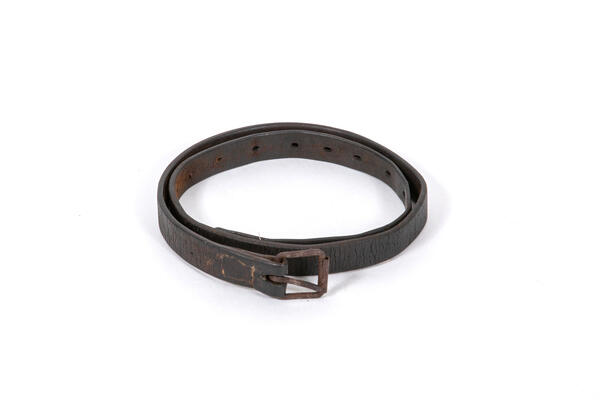The Red Army belt from the collection of the Museum Resource Center was found on a battlefield in the Rzhevsky District, Tver Oblast. The belt was sewn from gray-brown leather and has a steel frame buckle, which was attached to it by three parallel rows of stitching. It had a single pin — the prong which was inserted into the hole on the belt.
The width of the belt is 25 millimeters. It was not officially regulated in the mid-1920s, therefore different manufacturers made belts with a width of 25 to 45 millimeters.
At the beginning of the Great Patriotic War, the style of the uniform and the way it was worn were determined by order No.176 of the People’s Commissar of Defense of the USSR, dated from December 3, 1935. Soldiers and junior commanders had to wear a basic belt with an ordinary open buckle. By this time, its width was finally standardized — 45 millimeters. All items that were hung on the belt were adjusted to this width: pouches for grenades, cartridge bags, cases for aluminum canteens and infantry spades.
The Red Army belt was an important part of the uniform. The rules for wearing it were strict: ‘During military campaigns and exercises, by the order of the commander, it is allowed to lift and fasten the overcoat by hooks to the waist belt <…>. The gimnasterka (military smock) and overcoat at the waist should always be clinched with a belt; the folds of the gimnasterka and the back fold are carefully straightened; when belting the overcoat, the waist belt on the back should lay on the buttons, behind the strap. The front part of the belt should be slightly lower than the back, the buckle is located strictly in the middle of the body, and the end is tucked into the loops to the left side.’
On January 18, 1941, an order was issued by the Council of People’s Commissars of the USSR ‘On the changes in the uniform and regulations on the supply of the clothing to the personnel of the Red Army in peacetime and wartime and on the use of substitute equipment for humans and horses’. The leather of the belts was replaced by ‘cotton webbing’ which is a durable and inexpensive tarpaulin. These belts had a leather strip with loops and a small strap — a narrow ring that held the protruding buckle.
The width of the belt is 25 millimeters. It was not officially regulated in the mid-1920s, therefore different manufacturers made belts with a width of 25 to 45 millimeters.
At the beginning of the Great Patriotic War, the style of the uniform and the way it was worn were determined by order No.176 of the People’s Commissar of Defense of the USSR, dated from December 3, 1935. Soldiers and junior commanders had to wear a basic belt with an ordinary open buckle. By this time, its width was finally standardized — 45 millimeters. All items that were hung on the belt were adjusted to this width: pouches for grenades, cartridge bags, cases for aluminum canteens and infantry spades.
The Red Army belt was an important part of the uniform. The rules for wearing it were strict: ‘During military campaigns and exercises, by the order of the commander, it is allowed to lift and fasten the overcoat by hooks to the waist belt <…>. The gimnasterka (military smock) and overcoat at the waist should always be clinched with a belt; the folds of the gimnasterka and the back fold are carefully straightened; when belting the overcoat, the waist belt on the back should lay on the buttons, behind the strap. The front part of the belt should be slightly lower than the back, the buckle is located strictly in the middle of the body, and the end is tucked into the loops to the left side.’
On January 18, 1941, an order was issued by the Council of People’s Commissars of the USSR ‘On the changes in the uniform and regulations on the supply of the clothing to the personnel of the Red Army in peacetime and wartime and on the use of substitute equipment for humans and horses’. The leather of the belts was replaced by ‘cotton webbing’ which is a durable and inexpensive tarpaulin. These belts had a leather strip with loops and a small strap — a narrow ring that held the protruding buckle.


